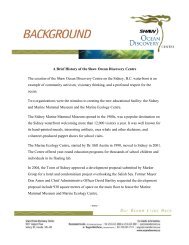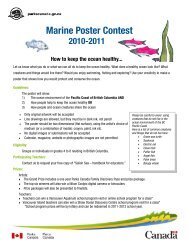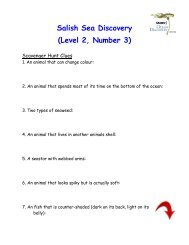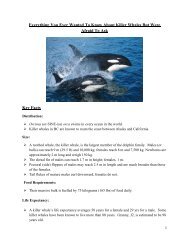Common Name: strawberry anemone - Shaw Ocean Discovery Centre
Common Name: strawberry anemone - Shaw Ocean Discovery Centre
Common Name: strawberry anemone - Shaw Ocean Discovery Centre
Create successful ePaper yourself
Turn your PDF publications into a flip-book with our unique Google optimized e-Paper software.
<strong>Common</strong> <strong>Name</strong>: <strong>strawberry</strong> <strong>anemone</strong><br />
Scientific <strong>Name</strong>: Corynactis californica<br />
(KOR-een-ACT-is kal-i-FOR-ni-ka)<br />
©Bernard P. Hanby<br />
Defining Characteristics<br />
• Max size of 2 cm high<br />
• Red, orange, or pink with whitish club-tipped tentacles<br />
• Mainly colonial<br />
Habitat & Range<br />
• Intertidal 45 m deep<br />
• Rocks in areas of strong current<br />
• British Columbia to Mexico<br />
Prey & Predators<br />
• Prey on copepods, invertebrate, fish larvae, crustaceans, snails<br />
• Predators are nudibranchs, sea stars<br />
Reproduction<br />
• Usually reproduce asexually by budding creating identical offspring<br />
• Reproduce sexually by broadcasting sperm and eggs<br />
Additional Information<br />
• Colonies of these <strong>anemone</strong>s can span 20 m wide<br />
© <strong>Shaw</strong> <strong>Ocean</strong> <strong>Discovery</strong> <strong>Centre</strong> 2009. Phylum Cnidaria
<strong>Common</strong> <strong>Name</strong>: swimming <strong>anemone</strong> / cowardly <strong>anemone</strong><br />
Scientific <strong>Name</strong>: Stomphia didemon<br />
(STOM-fee-ah DID-e-mon)<br />
©Bernard P. Hanby<br />
Defining Characteristics<br />
• Max size of 12 cm in diameter, 10 cm in height<br />
• Cream to bright orange column with white or banded tentacles<br />
Habitat & Range<br />
• Subtidal waters to 20 m deep<br />
• Sandy or shell-littered bottoms<br />
• Alaska to California<br />
Prey & Predators<br />
• Prey on crustaceans<br />
• Predators are nudibranchs, sea stars<br />
Reproduction<br />
• Reproduce sexually by broadcasting sperm and eggs<br />
Additional Information<br />
• This <strong>anemone</strong> will ‘swim’ by flexing its muscles in defense of predators<br />
• “Stomphia” means ‘saucer mouth’<br />
© <strong>Shaw</strong> <strong>Ocean</strong> <strong>Discovery</strong> <strong>Centre</strong> 2009. Phylum Cnidaria
<strong>Common</strong> <strong>Name</strong>: tube-dwelling <strong>anemone</strong><br />
Scientific <strong>Name</strong>: Pachycerianthus fimbriatus<br />
(PAK-ee-ser-ee-ANTH-us FIM-bree-A-tus)<br />
©Bernard P. Hanby<br />
Defining Characteristics<br />
• Max size of 20 cm in diameter, 35 cm in length<br />
• Two sets of banded, golden-brown to purple-black tentacles come out from a leather-like<br />
tube in the sand<br />
Habitat & Range<br />
• Intertidal to 30 m deep<br />
• Muddy, or sandy substrates<br />
• Produces a mucus-like, tough, leathery tube 60 cm into the mud/sand<br />
• Alaska to Mexico<br />
Prey & Predators<br />
• Prey on small invertebrates, plankton<br />
• Predators are giant nudibranchs<br />
Reproduction<br />
• Reproduce sexually by broadcasting sperm and eggs<br />
Additional Information<br />
• When approached by a predator, this <strong>anemone</strong> quickly retreats down its tube in the sand<br />
• The <strong>anemone</strong>’s tentacles can grow back after being attacked by predators<br />
• The giant nudibranch will lay its eggs on the tube of this <strong>anemone</strong><br />
• Some species in this genus of <strong>anemone</strong> have fluorescent tentacles that absorb UV light<br />
and re-emit it as visible light<br />
© <strong>Shaw</strong> <strong>Ocean</strong> <strong>Discovery</strong> <strong>Centre</strong> 2009. Phylum Cnidaria
<strong>Common</strong> <strong>Name</strong>: burrowing green <strong>anemone</strong> / moonglow <strong>anemone</strong><br />
Scientific <strong>Name</strong>: Anthopleura artemisia<br />
(AN-tho-PLUR-ah ar-TEM-iss-ee-ah)<br />
flickr.com<br />
Defining Characteristics<br />
• Max size 10 cm in diameter, 25 cm column<br />
• Long, slender tentacles with a buried column<br />
• Pink or orange to green-grey, brown, or black, often with white bands<br />
Habitat & Range<br />
• Intertidal to 30 m deep<br />
• Buried in sand to sandy-shell hash attached to a rock or shell<br />
• Prefers protected bays but also found on open coast<br />
• Alaska to southern California<br />
Prey & Predators<br />
• Prey on zooplankton, small bottom dwelling worms, fish, squid, herring eggs<br />
• Predators are nudibranchs, sea stars<br />
Reproduction<br />
• Broadcast sperm and eggs in the late spring-early summer<br />
• Can reproduce asexually by fission creating two identical animals<br />
Additional Information<br />
• At low tide, this organism may withdraw below the sand<br />
• Has a symbiotic relationship with an algae in the exposed tissues<br />
• Will attack other <strong>anemone</strong>s with white spherules—small bumps at the base of the<br />
tentacles that contain nematocysts<br />
© <strong>Shaw</strong> <strong>Ocean</strong> <strong>Discovery</strong> <strong>Centre</strong> 2009. Phylum Cnidaria
<strong>Common</strong> <strong>Name</strong>: crimson <strong>anemone</strong> / snakelock <strong>anemone</strong><br />
Scientific <strong>Name</strong>: Cribrinopsis fernaldi<br />
(kri-BRIN-op-sis fer-NAL-deye)<br />
Kirt L. Onthank<br />
Defining Characteristics<br />
• Max size of 20 cm column<br />
• Long, slender, drooping tentacles that drape over the column<br />
• White, yellow, or pink with a thin zigzag pattern<br />
• Small, white tubercles (raised spots) down the column<br />
• A ring of knobs called ‘contact tentacles’ are on the top edge of the column<br />
Habitat & Range<br />
• Subtidal to more than 300 m deep<br />
• Rocky substrate<br />
• Alaska to Puget Sound<br />
Prey & Predators<br />
• Prey on zooplankton, small bottom dwelling worms, fish, squid<br />
• Predators are nudibranchs, sea stars<br />
Reproduction<br />
• Young are brooded in the <strong>anemone</strong> and released as larvae into the ocean<br />
Additional Information<br />
• Contact tentacles are used for attacking other <strong>anemone</strong>s that get too close<br />
© <strong>Shaw</strong> <strong>Ocean</strong> <strong>Discovery</strong> <strong>Centre</strong> 2009. Phylum Cnidaria
<strong>Common</strong> <strong>Name</strong>: aggregating <strong>anemone</strong> / pink tipped <strong>anemone</strong><br />
Scientific <strong>Name</strong>: Anthopleura elegantissima<br />
(AN-tho-PLUR-a ELL-e-gan-TIS-e-ma)<br />
©Bernard P. Hanby<br />
Defining Characteristics<br />
• Max size of 10 cm across<br />
• Olive to bright green, with pink tips<br />
• Has a symbiotic relationship (living together for the benefit of each organism) with<br />
photosynthetic algae<br />
Habitat & Range<br />
• Intertidal up to 18 m deep<br />
• Rock walls, boulders, pilings<br />
• Semi-protected coastal waters<br />
• Alaska to Mexico<br />
Prey & Predators<br />
• Prey on copepods, amphipods, isopods<br />
• Predators are nudibranchs, leather star, mosshead sculpin<br />
Reproduction<br />
• Sexual reproduction by broadcasting sperm and eggs<br />
• Asexual reproduction by budding<br />
Additional Information<br />
• Colonies of aggregating <strong>anemone</strong>s are territorial and are actually at war against each<br />
other<br />
• They will sting members of neighboring colonies to keep them away<br />
© <strong>Shaw</strong> <strong>Ocean</strong> <strong>Discovery</strong> <strong>Centre</strong> 2009. Phylum Cnidaria
<strong>Common</strong> <strong>Name</strong>: giant green <strong>anemone</strong> / green surf <strong>anemone</strong><br />
Scientific <strong>Name</strong>: Anthopleura xanthogrammica<br />
(AN-tho-PLUR-a ZAN-tho-gram-i-ka)<br />
©Bernard P. Hanby<br />
Defining Characteristics<br />
• Max size of 30 cm across<br />
• Crown is greenish, bluish or white with dark brown column<br />
• Not aggressive to neighbours<br />
Habitat & Range<br />
• Intertidal to 30 m deep<br />
• Rocky exposed shores and tidepools<br />
• Alaska to Panama<br />
Prey & Predators<br />
• Prey on crabs, small fish, sea urchins, mussels<br />
• Predators are predatory snails, sea spiders<br />
Reproduction<br />
• Sexual reproduction only<br />
• Broadcasts sperm and eggs<br />
• Eggs are a brownish colour<br />
Additional Information<br />
• The largest green <strong>anemone</strong><br />
• More solitary than aggregating <strong>anemone</strong><br />
• Cover themselves with shells to reflect sunlight and keep cool when the tide goes out<br />
• Produce toxins that stimulate human heart muscle and have been considered for medical<br />
use<br />
• The more sun exposure this <strong>anemone</strong> receives, the brighter green it will be due to the<br />
increased growth of algae in its skin<br />
© <strong>Shaw</strong> <strong>Ocean</strong> <strong>Discovery</strong> <strong>Centre</strong> 2009. Phylum Cnidaria
<strong>Common</strong> <strong>Name</strong>: giant plumose <strong>anemone</strong><br />
Scientific <strong>Name</strong>: Metridium farcimen<br />
(meh-TRID-ee-um far-SEE-men)<br />
©Bernard P. Hanby<br />
Defining Characteristics<br />
• Average height is 25 to 75 cm tall<br />
• White, cream, tan, brown, orange in colour<br />
• Long broad column with many slender, short tentacles around oral disk<br />
Habitat & Range<br />
• Subtidal waters to 300 m deep<br />
• Rocks, floats, wharfs<br />
• Alaska to Mexico<br />
Prey & Predators<br />
• Prey on plankton, detritus<br />
• Predators are nudibranchs, sea stars<br />
Reproduction<br />
• Sexual reproduction by broadcasting sperm and eggs<br />
• Asexual reproduction<br />
• As the <strong>anemone</strong> moves it leaves behind parts of its base behind which grow into cloned<br />
<strong>anemone</strong>s<br />
Additional Information<br />
• Sting drifting organisms with their frilly tentacles<br />
• Have specialized tentacles that can reach 12 cm in length for defense against nonidentical<br />
<strong>anemone</strong>s<br />
© <strong>Shaw</strong> <strong>Ocean</strong> <strong>Discovery</strong> <strong>Centre</strong> 2009. Phylum Cnidaria
<strong>Common</strong> <strong>Name</strong>: short plumose <strong>anemone</strong> / powder puff <strong>anemone</strong><br />
Scientific <strong>Name</strong>: Metridium senile<br />
(meh-TRID-ee-um SEN-ill-ee)<br />
©Bernard P. Hanby<br />
Defining Characteristics<br />
• Max size of 10 cm in diameter, 5-10 cm tall<br />
• Range in colour from white, cream, brown, tan<br />
• A smooth column with up to 100 slender tentacles<br />
Habitat & Range<br />
• Intertidal to 300 m deep<br />
• Hard surfaces, on floats, in areas of strong current<br />
• Circumpolar (throughout the arctic circle), Alaska to southern California<br />
Prey & Predators<br />
• Prey on zooplankton, small bottom dwelling worms, fish, squid, kelp<br />
• Predators are nudibranchs, sea stars<br />
Reproduction<br />
• As it moves, small pieces of this <strong>anemone</strong>’s foot may break off to become new, identical<br />
<strong>anemone</strong>s (clones)<br />
• Reproduce sexually by broadcasting sperm and eggs<br />
Additional Information<br />
• These <strong>anemone</strong>s may even be found on the carapace of crabs<br />
• Anemones found at the border of a group of clones can develop ‘catch tentacles’ that will<br />
probe adjacent areas for different species of <strong>anemone</strong> and attack them with special<br />
nematocysts in these tentacles<br />
© <strong>Shaw</strong> <strong>Ocean</strong> <strong>Discovery</strong> <strong>Centre</strong> 2009. Phylum Cnidaria
<strong>Common</strong> <strong>Name</strong>: painted <strong>anemone</strong> / dahlia <strong>anemone</strong><br />
Scientific <strong>Name</strong>: Urticina crassicornis<br />
(UR-tih-SEE-nah CRASS-ee-COR-nis)<br />
©Bernard P. Hanby<br />
Defining Characteristics<br />
• Max size of 30 cm across<br />
• Several shades of colour; patches of red, green, or yellow on the column and red, white,<br />
or pink tipped tentacles<br />
• Splotchy like appearance on the base (disk column)<br />
Habitat & Range<br />
• Intertidal to 30 m deep<br />
• Rocky substrates<br />
• Circumpolar (throughout the arctic circle), Alaska to southern California<br />
Prey & Predators<br />
• Prey on small fish, crabs, molluscs<br />
• Predators are sea snails and sea stars<br />
Reproduction<br />
• Asexual reproduction by cloning<br />
• Sexual reproduction by broadcasting sperm and eggs<br />
Additional Information<br />
• Solitary <strong>anemone</strong><br />
• Cannot sting through a person’s skin<br />
• Can live for over 50 years<br />
© <strong>Shaw</strong> <strong>Ocean</strong> <strong>Discovery</strong> <strong>Centre</strong> 2009. Phylum Cnidaria
<strong>Common</strong> <strong>Name</strong>: proliferating <strong>anemone</strong> / brooding <strong>anemone</strong><br />
Scientific <strong>Name</strong>: Epiactis prolifera<br />
(ep-ee-AK-tis pro-LIFF-er-ah)<br />
©Bernard P. Hanby<br />
Defining Characteristics<br />
• Max size of 8 cm across and 10 cm tall<br />
• Varying shades of red, pink, green, or brown<br />
Habitat & Range<br />
• Intertidal to 18 m deep<br />
• Rocky substrates, coralline algae<br />
• Mainly dwell on eelgrass<br />
• Southern Alaska to southern California<br />
Prey & Predators<br />
• Prey on crab, shrimp, mussels<br />
• Predators are nudibranchs, leather star, mosshead sculpin<br />
Reproduction<br />
• Internal fertilization<br />
• Female adults are small<br />
• Large adults are mainly hermaphroditic<br />
• Cross and self fertilization can occur<br />
Additional Information<br />
• After hatching inside the adult <strong>anemone</strong>, the babies come out through the mouth and<br />
cling to the side of their parent until they are big enough to live on their own<br />
© <strong>Shaw</strong> <strong>Ocean</strong> <strong>Discovery</strong> <strong>Centre</strong> 2009. Phylum Cnidaria
<strong>Common</strong> <strong>Name</strong>: rose <strong>anemone</strong> / fish-eating <strong>anemone</strong><br />
Scientific <strong>Name</strong>: Urticina piscivora<br />
(UR-tee-SEE-nah PIS-i-VOR-ah)<br />
©Bernard P. Hanby<br />
Defining Characteristics<br />
• Max size of 30 cm across<br />
• Tentacles are hot pink or white<br />
• Broad dark maroon column with no markings<br />
Habitat & Range<br />
• Intertidal to 48 m deep<br />
• Alaska to California<br />
Prey & Predators<br />
• Prey on small fish, shrimp, other invertebrates<br />
• Predators are nudibranchs<br />
Reproduction<br />
• Sexual reproduction by broadcasting sperm and eggs<br />
• Asexual reproduction by budding<br />
• Juveniles are much brighter in colour and may look quite different<br />
Additional Information<br />
• This species has more powerful stinging tentacles than many other <strong>anemone</strong>s<br />
• They grow larger when food is plentiful and "grow" smaller when food is scarce<br />
• The painted greenling (Oxylebius pictus), has been observed lying unharmed in this<br />
<strong>anemone</strong> like clownfish do in tropical <strong>anemone</strong>s in symbiosis<br />
© <strong>Shaw</strong> <strong>Ocean</strong> <strong>Discovery</strong> <strong>Centre</strong> 2009. Phylum Cnidaria
<strong>Common</strong> <strong>Name</strong>: fried-egg jelly<br />
Scientific <strong>Name</strong>: Phacellophora camtschatica<br />
(FA-sell-o-FOR-a CAM-sha-TEE-ka)<br />
©Bernard P. Hanby<br />
Defining Characteristics<br />
• Max size of 60 cm<br />
• Opaque bell with yellow centre that looks like a fried egg<br />
• Has 16 clusters of a dozen or so tentacles<br />
Habitat & Range<br />
• Pelagic waters (open sea)<br />
• Alaska to Chile and Japan<br />
Prey & Predators<br />
• Prey on jellies, other zooplankton<br />
• Predators are sea turtles, ocean sunfish, blue rockfish<br />
Reproduction<br />
• Sexual reproduction by broadcasting sperm and eggs<br />
• Asexual reproduction by budding<br />
Additional Information<br />
• One of the biggest jellies in the Salish Sea<br />
• Because of its weak sting, small crustaceans ride the bell and drift along with the jelly in<br />
the current<br />
© <strong>Shaw</strong> <strong>Ocean</strong> <strong>Discovery</strong> <strong>Centre</strong> 2009. Phylum Cnidaria
<strong>Common</strong> <strong>Name</strong>: lion’s mane / red medusa<br />
Scientific <strong>Name</strong>: Cyanea capillata<br />
(SIGH-an-EE-a ca-PIL-ah-ta)<br />
©Bernard P. Hanby<br />
Defining Characteristics<br />
• Max size of 12 cm to 2 m across<br />
• Stinging tentacles can be 10 times the body length<br />
• Vivid yellow to orange or sometimes red in colour<br />
• Bell is divided into 8 lobes with many tentacles<br />
Habitat & Range<br />
• Pelagic waters (open sea)<br />
• Alaska to Mexico<br />
Prey & Predators<br />
• Prey on zooplankton and small fish<br />
• Predators are seabirds, larger fish, sea turtles, other jellies<br />
Reproduction<br />
• Sexual reproduction in the medusa stage<br />
• Asexual reproduction in the polyp stage<br />
• Young fish huddle under parents as they swim<br />
Additional Information<br />
• Warning! Have painful sting, humans who touch tentacles may develop a bee-like sting<br />
• This jelly was used in the Sherlock Holmes short story “The Adventure of the Lion’s<br />
Mane”<br />
© <strong>Shaw</strong> <strong>Ocean</strong> <strong>Discovery</strong> <strong>Centre</strong> 2009. Phylum Cnidaria
<strong>Common</strong> <strong>Name</strong>: sea nettle<br />
Scientific <strong>Name</strong>: Chrysaora fuscescens<br />
(krih-SAH-or-ay few-SESH-ens)<br />
©Bernard P. Hanby<br />
Defining Characteristics<br />
• Bell size of 1 m in diameter<br />
• Tentacle length of up to 4.6 m<br />
• Golden-brown bell with 24 maroon tentacles and white oral arms<br />
Habitat & Range<br />
• Pelagic waters (open sea)<br />
• Alaska to California, Japan, Kamchatka, the Bering Sea<br />
Prey & Predators<br />
• Prey on young pollock, larval fish, zooplankton, other jellies<br />
• Predators are seabirds, sunfish, sea turtles<br />
Reproduction<br />
• Males broadcast sperm and females broadcast eggs<br />
Additional Information<br />
• Warning! The trailing tentacles have quite a sting if you touch them<br />
• The long, trailing tentacles contain stinging cells that contain small barb-like structures<br />
called nematocysts that sting and paralyzes prey<br />
• Fishing down the food chain and other human affects on coastal regions may have<br />
created more favorable conditions for jellies<br />
• Sometimes small crabs find shelter within this jellyfish<br />
© <strong>Shaw</strong> <strong>Ocean</strong> <strong>Discovery</strong> <strong>Centre</strong> 2009. Phylum Cnidaria
<strong>Common</strong> <strong>Name</strong>: water jellies / many ribbed medusa<br />
Scientific <strong>Name</strong>: Aequorea spp.<br />
(ee-KWOR-ee-ah)<br />
©Bernard P. Hanby<br />
Defining Characteristics<br />
• Max size of 17.5 cm in diameter, 4 cm high<br />
• Thick, colourless, transparent bell with white radial stripes resembling a bicycle wheel<br />
with spokes<br />
• Produce green bioluminescent pattern<br />
Habitat & Range<br />
• Pelagic coastal waters (open sea)<br />
• Alaska to Mexico<br />
Prey & Predators<br />
• Prey on crustaceans, other jellyfish, free-swimming tunicates<br />
• Predators are other jellies<br />
Reproduction<br />
• Reproduce sexually by broadcasting sperm and eggs<br />
Additional Information<br />
• These jellies contain a similar chemical to the one that lights up fireflies at night<br />
© <strong>Shaw</strong> <strong>Ocean</strong> <strong>Discovery</strong> <strong>Centre</strong> 2009. Phylum Cnidaria
<strong>Common</strong> <strong>Name</strong>: moon jelly / white sea jelly<br />
Scientific <strong>Name</strong>: Aurelia labiata<br />
(AWH-rell-EE-ah la-BEE-ah-TA)<br />
©Bernard P. Hanby<br />
Defining Characteristics<br />
• Max size of 40 cm across<br />
• Lack long trailing tentacles but have many little tentacles<br />
• Four central distinctive pinkish, yellow or purple ‘horseshoes’ shapes (sex oragns)<br />
Habitat & Range<br />
• Pelagic coastal waters (open sea) including bays and inlets<br />
• Alaska to California<br />
Prey & Predators<br />
• Prey on zooplankton using stinging cells and sticky mucus to catch food<br />
• Predators are birds, turtles, other jellies<br />
Reproduction<br />
• Sexual reproduction in the medusa stage<br />
• Asexual reproduction in the polyp stage by budding<br />
• Internal fertilization<br />
• Spawn in sheltered bays<br />
Additional Information<br />
• When spawning, great clouds of moon jellies appear close to shore and get washed onto<br />
beaches in storms<br />
© <strong>Shaw</strong> <strong>Ocean</strong> <strong>Discovery</strong> <strong>Centre</strong> 2009. Phylum Cnidaria
<strong>Common</strong> <strong>Name</strong>: red-eye medusa / bell-shaped jelly fish<br />
Scientific <strong>Name</strong>: Polyorchis penicillatus<br />
(POL-EE-or-kis pen-i-sill-a-tus)<br />
©Bernard P. Hanby<br />
Defining Characteristics<br />
• Max size of 10 cm in height<br />
• Transparent, colourless bell with yellow, brown, or purplish organs<br />
• Tiny red eye spots where the bell meets the tentacles are light sensitive to help orient<br />
itself<br />
Habitat & Range<br />
• Pelagic coastal waters (open sea) including bays and inlets<br />
• Alaska to Mexico<br />
Prey & Predators<br />
• Prey on zooplankton, worms, crustaceans<br />
• Predators on birds, sea turtles<br />
Reproduction<br />
• Separate sexes<br />
• Sexual reproduction<br />
Additional Information<br />
• This jelly picks up food as it drifts over the bottom<br />
• Benthic medusa, generally stays near the bottom<br />
© <strong>Shaw</strong> <strong>Ocean</strong> <strong>Discovery</strong> <strong>Centre</strong> 2009. Phylum Cnidaria








